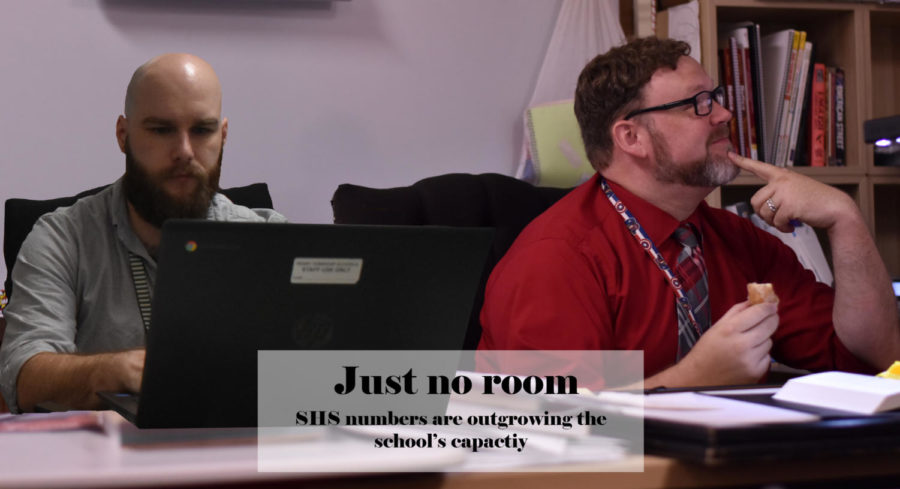Just no room
SHS numbers are growing out of the school’s capacity
English teachers Matt Norris and Jake Fritz work during class. The two teachers share the classroom and work during different periods. photo illustration by Gretchen Turner and Josiah Veen
SHS has recently taken in an excess of new teachers, causing some of them to be assigned to multiple rooms at once and forcing them to migrate from room to room.
Traveling teachers have become a commonality at SHS over the last three to four years. The school is rapidly running out of space and was already forced to fill in several courtyards in 2012.
SHS was not built to house the current student population (around 2,300 students). Despite the additions throughout the years, the last one was finished eight years ago.
 SHS has somewhere close to 67 floor plan changes due to the additions to the building over the years. The sporadic nature of these additions has turned the building into a maze of hallways, staircases and rooms that have only somewhat been simplified by a main hallway. Many students and faculty members have coined this hallway the Fishbowl.
SHS has somewhere close to 67 floor plan changes due to the additions to the building over the years. The sporadic nature of these additions has turned the building into a maze of hallways, staircases and rooms that have only somewhat been simplified by a main hallway. Many students and faculty members have coined this hallway the Fishbowl.
Jake Fritz, an English teacher at SHS, is currently sharing a room with fellow SHS English teacher Matthew Norris.
The classroom is where teachers spend most of their time. Despite this, 10 teachers currently don’t have one. Through the loss of the resources provided by an allocated room, teachers have become hampered while teaching, limiting the ability of teachers to do their job.
“I’d like to think that I would be doing a little bit better,” Norris said. “You can start class right on time …You don’t have to move, set up, get everything ready.”
Not only is the loss of a classroom limiting teachers’s ability to teach, it also affects their connection with students and the interpretations that those students make of their teacher.
“That class setting is a part of who that teacher is,” Fritz said.
One teacher has seen the situation the school is in and has attempted to do his part in helping alleviate it.
“I’ve been here seven years and I voluntarily gave up my classroom,” said SHS Business department chair Bernard Cissell.
Cissell was in a unique situation as he only taught three periods of an accounting class, making him able to do most of his work at a computer and desk and not requiring most of the commodities teachers normally use.
This exists outside of the systems in place, where there is seniority amongst teachers. Teachers that have been in the building longest get first choice on classrooms that open up, leaving new teachers in the situation that they are in.
“It’s hard to tell somebody that’s been here and that’s been in the building for five years ‘Hey we’re going to bring in somebody that we don’t know at all and give them the classroom,’” Knight said.
Teachers who work on carts have to log into their computer, set up their lesson and unpack their things while being asked questions by students. Making their job infinitely more stressful.
“Sometimes I’ll walk into a room and the seating chart will be changed, their desks will be changed,” said Norris. “Now I’ll have to redo mine.”












